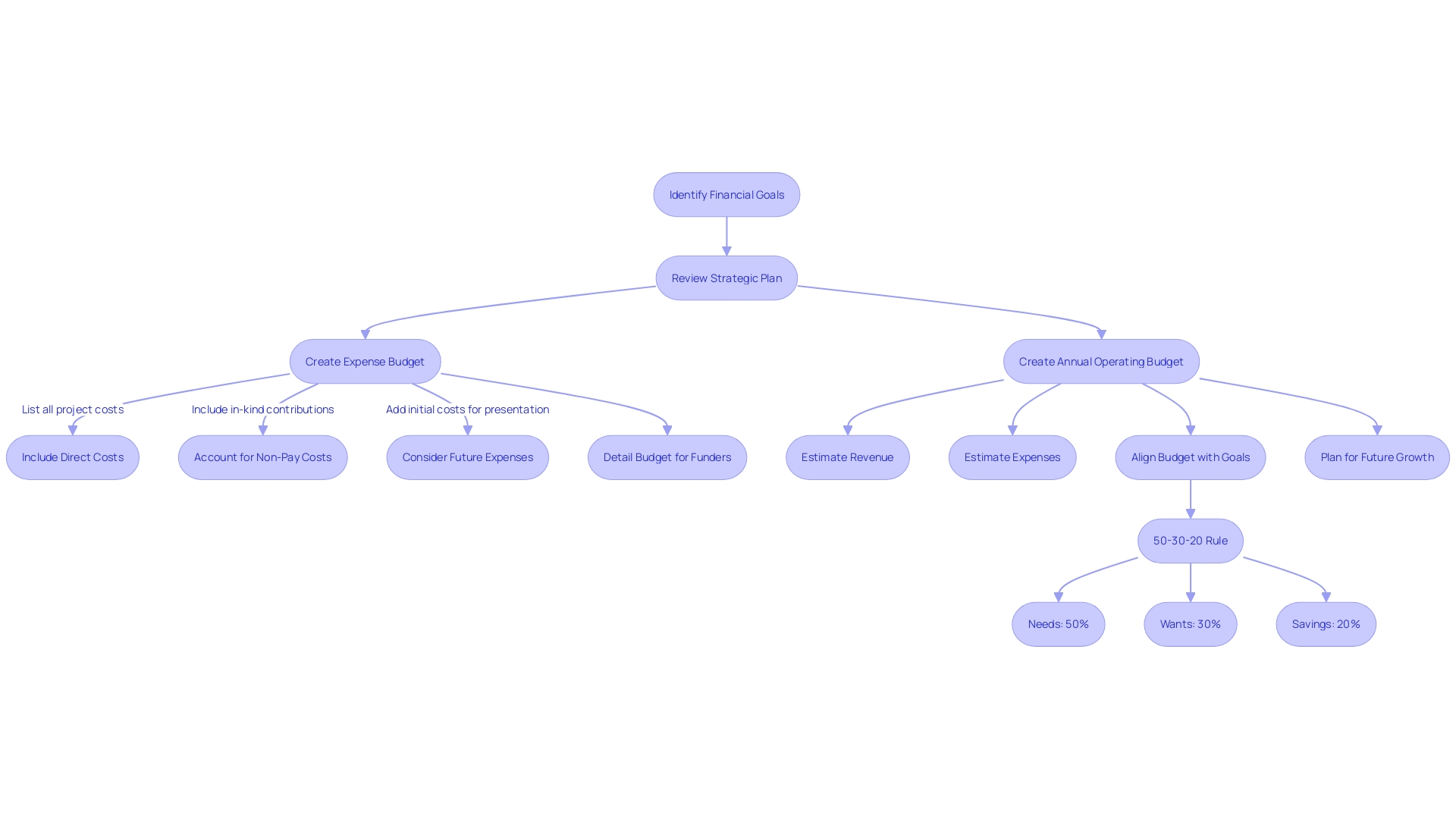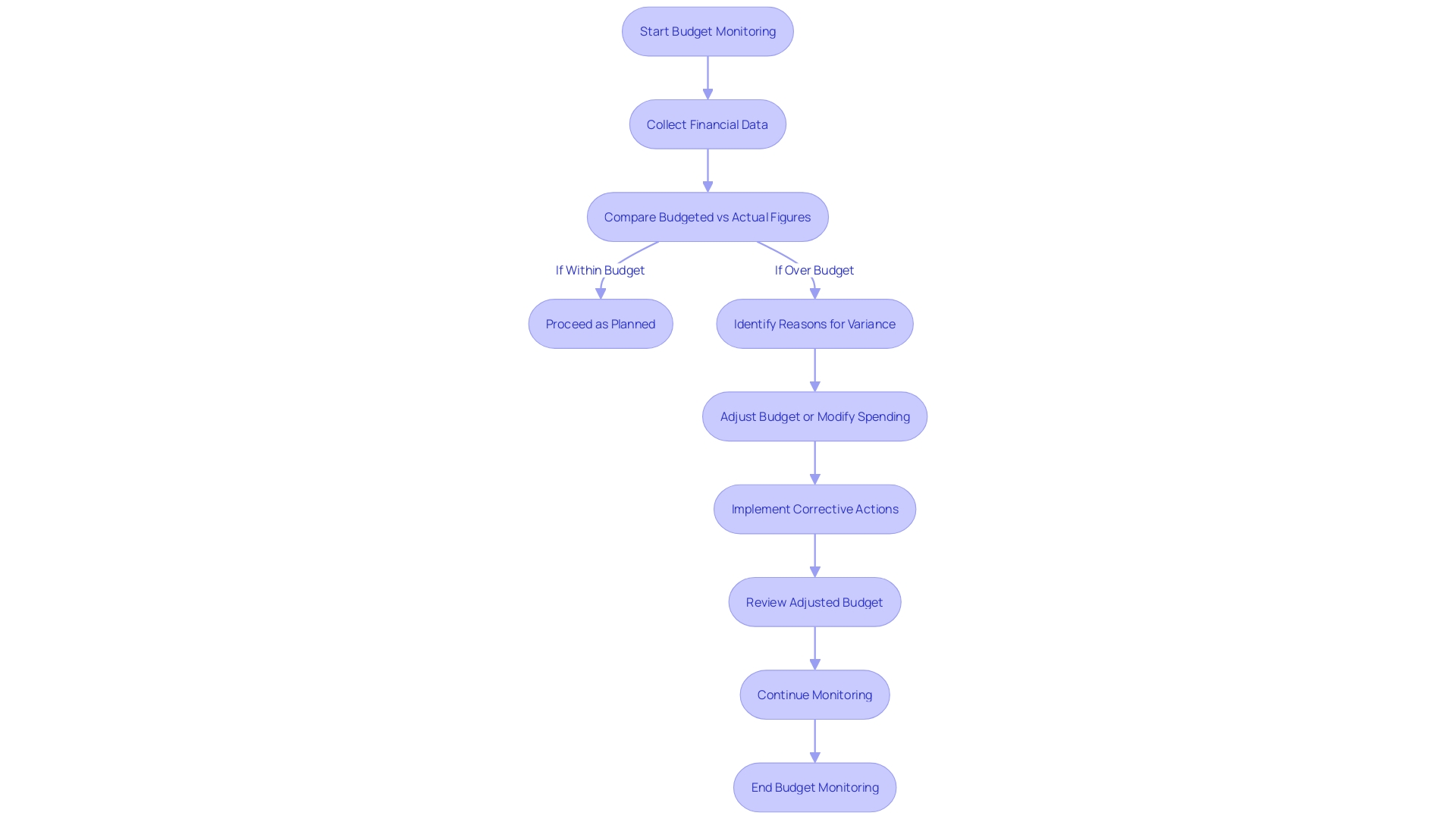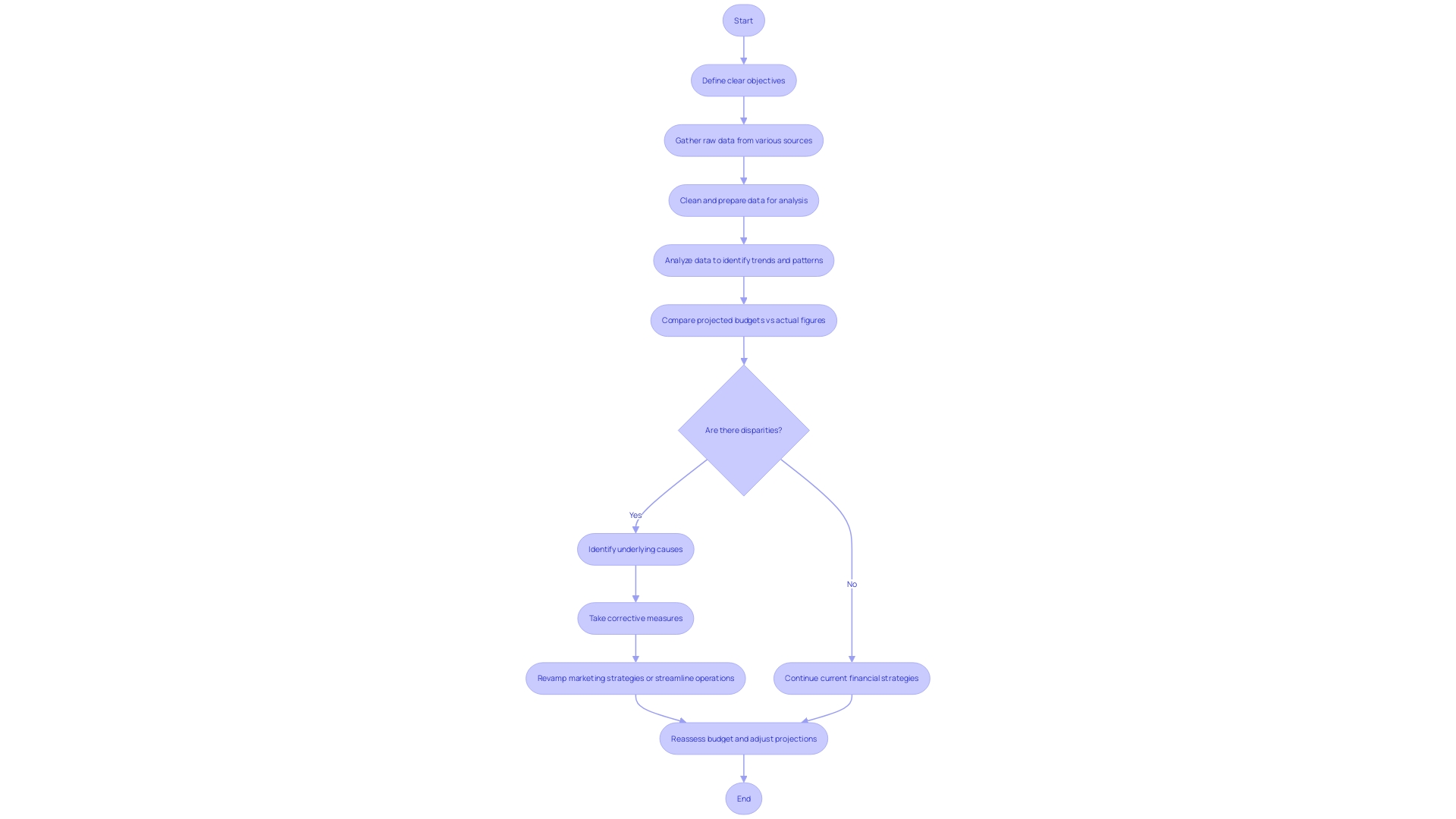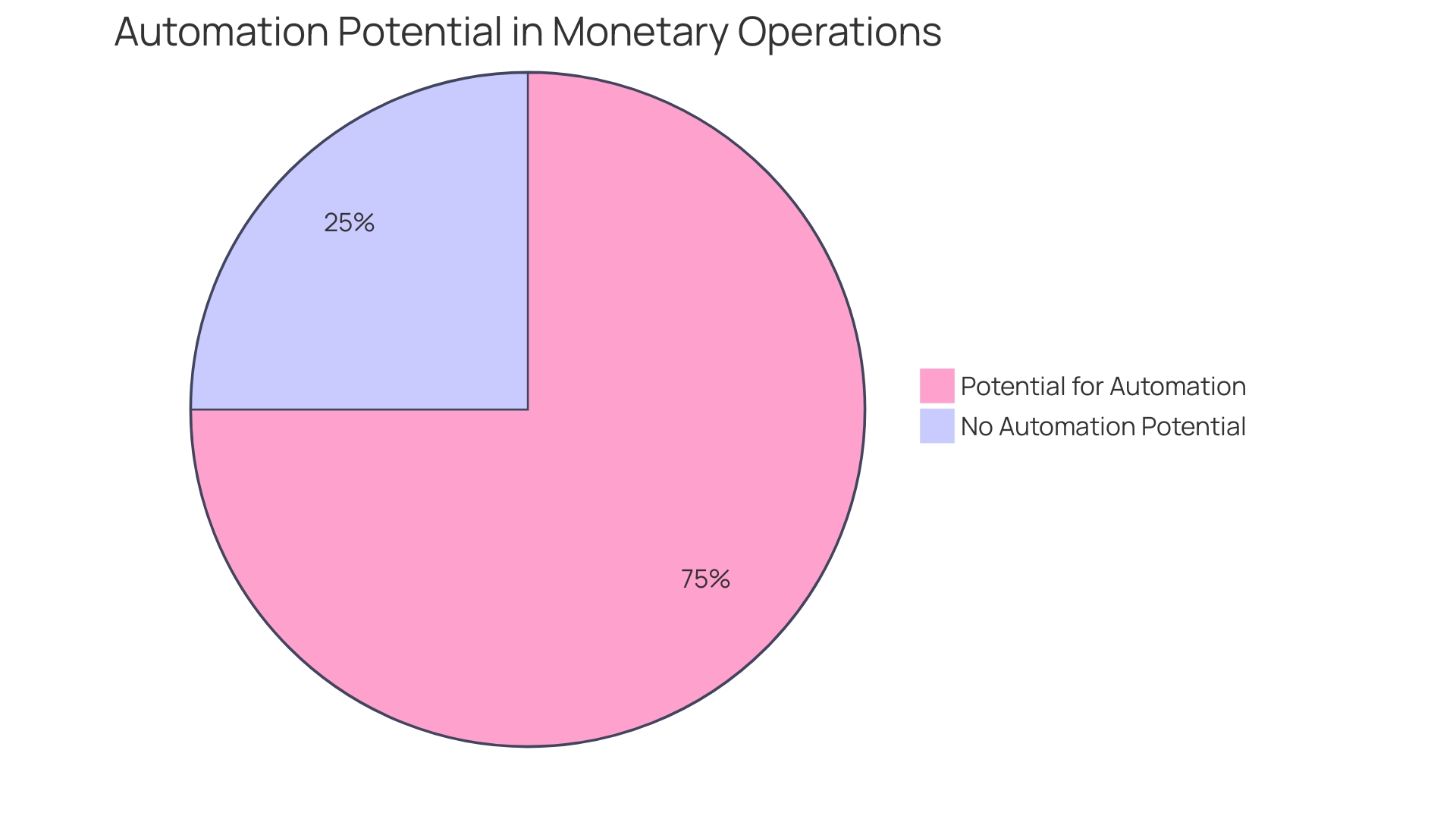Introduction
Understanding budget variances is crucial for businesses to enhance performance and refine their financial strategies. It goes beyond pinpointing discrepancies and delves into the underlying factors driving those differences. In this article, we explore the intricacies of budget vs actual variance analysis and its importance in financial management.
We discuss the types of budget variances, the steps for performing budget variance analysis, and how to create a budget variance analysis report. Additionally, we highlight the benefits of automating budget variance analysis and the implications of not embracing automation in financial operations. By following these practical insights, CFOs can make informed decisions and ensure the financial health and strategic direction of their organizations.
What is Budget vs Actual Variance Analysis?
Comprehending the complexities of budget disparities is vital for any flourishing enterprise, as it reveals the differences between the projected and actual financial outcomes. This form of analysis is not just about pinpointing discrepancies; it's an exploratory journey that reveals the underlying factors driving those differences. With a keen eye on both the successes and the shortcomings illuminated by the variances, organizations can channel their efforts into enhancing performance and refining their strategic financial direction.
One might consider the Rule of X as an insightful concept that transcends the traditional Rule of 40 by incorporating a weighted approach to growth and cost optimization. It's a reminder that a growth mindset and precise calculations are pivotal for maximizing a company's value potential. Moreover, modern data quality practices now extend beyond structured internal data, embracing a myriad spectrum of data types from various sources, including unstructured and external data. This change is essential for handling and organizing the vast amount of data that enterprises face in the present.
It's crucial for companies to embrace a systematic approach to budgeting, as emphasized by various methodologies such as value creation planning plus (VCP+), precedent-based budgeting, integrated planning (IP), and zero-based budgeting (ZBB). The chosen method is secondary to the robustness of the process established around it. Starting early and maintaining a disciplined approach can prevent the budgeting process from becoming a haphazard, mismanaged task that often falls behind schedule.
In the modern era, tools like Babbage Insight redefine intelligence by monitoring metrics, extracting insights, and offering visual, easy-to-understand presentations with a focus on easy reconciliation. Such advancements highlight the significance of agility and precision in analysis and reporting, ensuring businesses stay proactive in their management of finances.

Types of Budget Variances
Budget vs actual difference analysis is crucial for financial management, involving a thorough examination of three core differences: revenue, expense, and profit. Revenue analysis illuminates the difference between projected and actual earnings, providing observations into sales performance and market conditions. For example, a company expecting a 5% increase in sales but achieving only 2% would need to scrutinize the market factors and internal processes that led to this shortfall. On the other hand, expense analysis concentrates on the disparities between projected and actual costs. An insightful case is that of AspirE, a data analytics firm that closely monitors its database costs due to their critical role in operations. As expenditures can fluctuate due to unforeseen events – such as new initiatives or market shifts – it's crucial to understand their impact on economic well-being. Lastly, profit difference, the disparity between anticipated and real profit, mirrors the general financial performance. Gross profit, a key metric, is calculated by subtracting the direct costs of production (COGS) from total revenue, a fundamental indicator of efficiency and profitability.
Understanding these variances allows organizations to make informed decisions, whether it's adjusting marketing strategies, renegotiating supplier contracts, or reallocating resources. For example, school districts customize their financial plans by allocations, assigning funds for particular objectives like salaries or projects, underlining the significance of precise financial planning in enhancing operations. Businesses must also prepare for unexpected costs and the reality that projects may not always unfold as planned. Staying updated on economic forecasts, like those from Kiplinger, aids in anticipating alterations that could impact future financial plans. In the end, a thorough analysis of differences is not just about crunching numbers but also about strategic planning and fostering resilience against unexpected monetary events.
Calculating Budget Variance
When addressing the intricate undertaking of budget analysis, CFOs must compare real outcomes against the planned budget. The calculation is straightforward: Budget Variance = Actual Amount - Budgeted Amount. However, the simplicity of the formula disguises the complex nature of analysis on differences in practice.
Variability in financial performance is as expected as the differences in product quality and market success. Just like in other industries, a detailed comprehension of when and why these differences take place is essential. To accurately understand a difference, one must consider it within the context of the organization's operations and strategic goals. A difference can be considered favorable if the actual amount exceeds the budgeted figure, indicating higher revenues or lower expenses than anticipated. On the other hand, an real quantity that does not meet the expected amount indicates an undesirable difference, frequently prompting a more detailed examination to determine the root causes.
Market variance, similar to volatility, is a significant factor in planning and cannot be overlooked. The constantly changing nature of markets requires ongoing monitoring and adjustment of both financial plans and actual results to guide a company towards its financial targets.
Furthermore, employing a properly organized business financial plan pattern, such as the exemplar financial plan pattern devised for establishments, can be crucial. Such templates not only assist in the initial budgeting process but also provide a clear framework for comparing actual results, making the task of difference analysis more manageable and insightful.
Considering the present economic situation, as emphasized by the challenges faced by the Welsh Government's preliminary financial plan, it is clear that financial planning and deviation examination are increasingly vital. Departments across the spectrum are required to make financial reductions, reinforcing the necessity for precise fiscal planning and watchful control of actual spending.
Ultimately, the effectiveness of budget variance analysis hinges on the alignment of the chosen method with the organization's complexity and the thoroughness of the process surrounding it. Whether employing dynamic models like value creation planning plus (VCP+), precedent-based budgeting, integrated planning (IBP), or zero-based budgeting (ZBB), the key is in the disciplined execution of the chosen approach. CFOs must begin early and carefully oversee the process to guarantee the health and strategic direction of their organizations.

Understanding Favorable and Unfavorable Variances
Attaining a favorable difference in monetary results is similar to a company exceeding its own anticipations. It reflects situations where revenues surpass forecasts or expenses fall short of projections, essentially serving as a beacon of operational efficiency and strategic success. However, the other side of the coin presents unfavorable variances, which signal a deviation from the fiscal roadmap—when actual revenues disappoint or expenses balloon beyond the budgeted framework. This discrepancy not only sheds light on performance gaps but also calls for a strategic review to realign the trajectory with its financial targets.
To contextualize, consider a business that prioritizes value maximization over mere profit generation. A positive difference in such a situation could be the outcome of strategic investments aimed at long-term growth, even at the cost of short-term profitability. On the other hand, an unfavorable difference may lead to a reconsideration of the company's strategic choices, including investment options and the equilibrium between shareholder profits and reinvestment.
The economic landscape is constantly changing, as demonstrated by the Federal Reserve's recent success in curbing inflation through assertive rate hikes, defying the anticipated recession. This underscores the importance of agility and informed decision-making in finance. Companies must navigate through a complex global web of supply chains, where efficiency is paramount, as indicated by the New York Federal Reserve's monitoring of supply chain pressure.
Including tools like ratios in the analysis of differences is crucial. These ratios distill voluminous financial data into actionable insights, facilitating comparisons with industry benchmarks and guiding pivotal business decisions. For example, a lower than anticipated expense ratio could result in a favorable difference, indicating operational excellence. On the flip side, an unfavorable difference in the debt-to-equity ratio might signal excessive leverage, necessitating corrective measures.
Ultimately, the understanding of differences is not only about numbers but entails a strategic evaluation of the underlying organizational decisions, market conditions, and the overarching objective of value maximization.
Steps for Performing Budget Variance Analysis
To guarantee economic stability and expansion, organizations must closely monitor their budget in comparison to actual monetary results. The process begins by gathering actual financial results alongside the intended financial figures. This data collection is crucial as it sets the foundation for subsequent analysis.
After the data is gathered, the subsequent stage is determining differences for every budget item, which includes subtracting the intended budget from the real expenses or revenues. This calculation of differences reveals the deviations and sets the stage for the critical analysis phase.
Examining these differences is when the strategic element of money management comes into action. It's about exploring each difference and comprehending the underlying factors contributing to these variations. For instance, market shifts, competitive actions, or pricing adjustments can all affect the financial outcomes in comparison to the budget.
It is crucial to identify the underlying reasons for these differences. It could be because of market dynamics, like the significant influence a few companies may have on an industry, as observed in California's wildfire risks, or it could be related to operational aspects such as the quality of output and the frequency of unexpected work like bug fixes, which can result in differences in both costs and revenues.
The final step involves taking corrective actions based on the insights gained. This could indicate modifying approaches, enhancing operational effectiveness, or taking advantage of favorable circumstances that resulted in positive differences. For example, prosperous enterprises and writers frequently surpass averages by skillfully utilizing their strengths, which is a notion that can be similarly employed in variance management.
By strictly adhering to these steps, organizations are empowered to make informed decisions that propel their economic performance forward. The analysis not only aids in understanding the economic landscape but also prepares organizations to adapt and thrive in challenging economic conditions, as highlighted by the spending reductions across various departments in the Draft budget of the Welsh Government.

Analyzing Variances: Identifying Causes and Taking Action
In the domain of money management, analyzing disparities between projected budgets and actual figures is a crucial exercise. It's not merely about nothing discrepancies; it's an investigative process to unearth the underlying causes. Recognizing these triggers empowers companies to take corrective measures. For example, a shortfall in revenue might be a cue to revamp marketing strategies to elevate sales. Conversely, if rising costs are tied to inefficiencies, streamlining operations could be the antidote to bolster the bottom line.
To illustrate, let's take a cue from Alex Hormozi, a successful entrepreneur managing a portfolio of companies worth millions. He leverages the Theory of Constraints (TOC) to identify and address bottlenecks, enhancing analytics' impact. Similarly, high-performance traits like strategic thinking and adaptability, as emphasized by European business leaders, are crucial in navigating budget fluctuations.
Innovation also plays a pivotal role. Consider Wintershall Dea, a European gas and oil titan, that has harnessed AI for operational efficiency. Their forward-thinking approach underscores the importance of technological adoption in staying ahead of the curve.
Guiding principles like attentiveness to weak signals can act as an early warning system, signaling the need for a financial review. A structured approach is vital for assessing and responding to these variances, which includes sharp focus on customer and team engagement, as performance is often tied to the customer experience. Changes in market dynamics, like those in the domain industry, act as a reminder that market trends can shift rapidly, requiring flexible and well-informed decision-making supported by time series analysis and other data analytics tools.
Ultimately, the objective is value maximization, a principle that steers every enterprise decision, from investments to shareholder returns. As businesses anticipate the future, they rely on interconnected supply chains, as evidenced by the New York Federal Reserve's tracking of global supply chain pressure. Against the backdrop of an evolving marketplace, insights from the 2024 State of Revenue Report reveal that data analytics is becoming increasingly crucial in managing revenue and ensuring compliance. Businesses are thus compelled to adapt and innovate, ensuring their monetary strategies and operations are robust and responsive to the ever-changing economic landscape.

Creating a Budget Variance Analysis Report
To ensure that an organization maintains fiscal well-being and agility, it's critical to conduct a detailed Budget Variance Analysis, which is more than just a report; it's a strategic tool that dissects the discrepancies between projected and actual monetary outcomes. Such an analysis not only identifies deviations but also provides a structured approach for stakeholders to comprehend and act on these insights.
-
Executive Summary: A concise section that summarizes the core of the analysis, highlighting the most influential findings that could guide decision-making.
-
Variance Summary: An organized table that delineates each budget item's expected versus actual figures, offering a clear, at-a-glance view of the economic landscape.
-
Detailed Analysis: A deeper exploration into the most significant variances, thoroughly examining the root causes and formulating potential strategies to mitigate any negative impacts.
-
Recommendations: Strategic advice derived from the analysis, aimed at optimizing performance and ensuring that the organization's fiscal path aligns with its strategic objectives.
-
Conclusion: A recapitulation that highlights the significance of the analysis and the need for ongoing monitoring to support dynamic and informed planning.
Incorporating real-world considerations, such as economic variables and their impact on revenue and expenditures, is essential. Take into consideration the approach of the Congressional Budget Office, which involves interactive tools that account for uncertainty in demographic trends, federal actions, and economic conditions, emphasizing the significance of adaptability in planning.
Moreover, the significance of a well-thought-out budgeting process cannot be overstated. It begins with choosing a method—be it dynamic models, precedent-based budgeting, or zero-based budgeting—that suits the organization's needs. However, the real value lies in the diligent management and timely execution of this process, as echoed by experts in the field.
As we navigate a challenging economic landscape, characterized by reductions in funding across various sectors like those in the Welsh Government's Draft financial plan, the ability to analyze and adjust funding becomes ever more crucial. The goal is to enable organizations to preempt shortfalls and strategize effectively, ensuring that each investment is justified and its impact meticulously considered.

Automating Budget Variance Analysis
Embracing the power of automation in fiscal operations, specifically in budget variance analysis, is becoming a game-changer for organizations. Through sophisticated tools such as Amazon QuickSight and advanced Business Process Management (BPM) systems, companies can significantly reduce manual data entry and minimize errors. This leap toward automation not only provides real-time insights but also allows for consistent tracking of performance, creating opportunities for swift corrective actions.
For example, using Amazon QuickSight's intuitive natural language querying, companies can quickly generate insightful reports, providing a competitive advantage through timely decision-making. Moreover, the implementation of BPM ensures that the entire process is streamlined, from design to monitoring, emphasizing continual improvement.
The implications of not adopting such advancements are stark. According to recent trends, an impressive 80% of monetary operations hold potential for automation, as emphasized by Accenture. Failing to harness this potential could result in businesses falling behind, especially when competitors are likely to leverage automation to improve their market position. In fact, adopting intelligent automation has been linked to a 73% revenue growth in overall Net Present Value (NPV) benefit and a 5.4% compound annual growth rate (CAGR) over three years for composite customers, according to Forrester's Total Economic Impact methodology.
Automation in monetary departments isn't widespread yet, but the path is clear. As organizations confront unprecedented financial pressures and staffing challenges, the transition to automated systems appears not just beneficial but imperative for maintaining a competitive stance in the market, especially when considering the enhanced capacity for strategic initiatives and heightened customer satisfaction that comes with it.

Conclusion
Understanding budget variances is crucial for businesses to enhance performance and refine their financial strategies. By performing budget variance analysis, organizations can gain insights into revenue, expense, and profit variances, allowing them to make informed decisions and take corrective actions. This systematic approach involves collecting real financial outcomes, calculating variances, analyzing underlying factors, and implementing necessary changes.
Creating a budget variance analysis report is essential for stakeholders to comprehend and act on the insights gained. The report should include an executive summary, a variance summary, a detailed analysis of significant variances, recommendations for optimizing financial performance, and a conclusion emphasizing the importance of continuous monitoring and dynamic financial planning.
Embracing automation in financial operations is becoming increasingly important. Automation tools like Amazon QuickSight and BPM systems can reduce manual data entry, minimize errors, provide real-time insights, and allow for consistent tracking of financial performance. Failing to adopt automation could result in falling behind competitors who are leveraging automation to improve their market position.
In conclusion, CFOs must embrace budget variance analysis as a strategic tool for driving financial performance. By understanding and analyzing variances, taking corrective actions, and leveraging automation, organizations can ensure their financial health, optimize operations, and stay ahead in a rapidly evolving marketplace.




